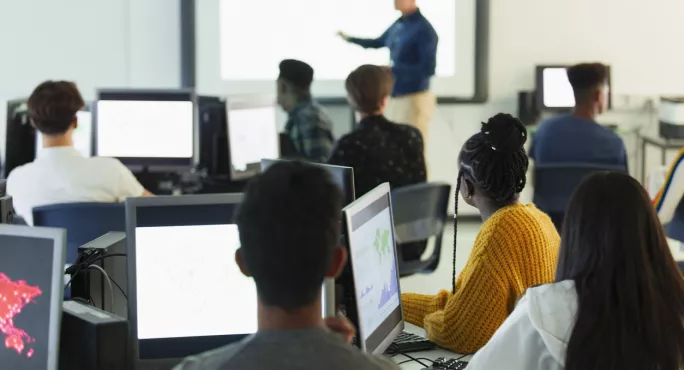As we move towards 1:1 computing, can schools keep up?

The Covid-19 pandemic has been many things, including a catalyst for education to accelerate its embracing of technology.
A recent study of 2,000 UK teachers, conducted by the Centre for Economics and Business Research (CEBR), found that the number one tech priority was more computers for students.
It reports that nearly half of students had access to school computers at least four times a week, but it was unusual to provide devices that they could take home, with only 3 per cent of the teachers surveyed working at schools where this was common practice.
In April, the government issued a £100 million package to fund laptops and 4G wireless routers for around 540,000 vulnerable pupils, but then slashed allocations by 80 per cent.
“The pandemic has amplified the fact that there is still a digital divide, despite a lot of people thinking there wasn’t,” says Carla Aerts, an edtech thought leader, consultant and mentor. “This divide is also not just about access to devices, it’s also how these devices are used.”
Different digital models
Schools across the UK have adopted different models to ensure that their students have a device. Private schools often ask students to bring their own devices, while many state schools lend devices to students whose families cannot afford to buy them. Some offer leases, at the end of which the device is fully paid for and belongs to the student.
Claire Jones is deputy headteacher at Layton Primary School, which now has a 1:1 iPad programme for its students.
“You also have to think about how the pandemic has affected homes,” she says. “Parents have lost jobs or been put on furlough, and some are looking after family members who are ill with Covid. Not everyone can afford a device for their child.”
But even when children do have devices, the unreliable (or non-existent) wi-fi in many households across the UK - 1.9 million, according to estimates - presents another challenge for online learning. And then there’s the issue of being able to use these devices in the right way.
Security is a major issue, explains Neil Sawyer, HP’s channel and education director.
“Safeguarding and securing mobile devices through device-level security has been essential,” he says. “Particularly as learning resources are accessed through a school’s protected network and also public/home networks.
“Resilience, reliability, safety and security are vital parts of any teaching aid. Making the right decision is essential, and we appreciate that there is often only one chance to get this right every five years. We have found that schools are more consultative in their approach now. We are miles beyond the ‘fund it fast and buy it even faster’ approach to technology.”
Inconsistency issues
Rory Steel is head of Digital Jersey Academy, the island’s first centre for digital education. He says that although a lot of Jersey students are able to access a device of some description, the lack of consistency can be problematic.
“If students just have mobile devices, these do not behave in the same way as a laptop,” he says. “What happens is that they may be able to do video tutorials on a phone or tablet, but producing their own work on it can become difficult.”
Jones says that while most schools have had to speed up plans relating to devices for their students, much of this process has taken place in a “panic” because of the pandemic, rather than through “actual thought” on how to make digital learning sustainable and effective.
Andrew Caffrey is CEO of Canopy, a London-based organisation that provides edtech training to schools. He says that many teachers worry that pupils aren’t taking in information effectively during online classes.
Experts say that’s because teachers aren’t always confident handling technology and have moved to a more instructional form of teaching than usual.
“We know in class that the best model for learning is not when kids are sitting and listening to a lesson for 45 minutes straight,” says Aerts. “And when you do that online through Zoom or Google Classrooms, that’s not going to work either.”
Instead, edtech leaders and digitally skilled teachers recommend new approaches to support technology-based learning. Keeping lesson content short, through bite-sized videos, can help, along with interactive activities and opportunities for feedback such as chat boxes, survey forms and polls, and sharing individual pupils’ work so the entire class can engage with it.
Computing collaboration
There are simple ways to boost collaboration, too, like allowing multiple students to edit the same document or using breakout rooms in apps like Zoom, where students can work within smaller groups.
“Good teaching online is not very different from good teaching in the classroom,” says Caffrey. “There needs to be recognition of how much training both teachers and students need if they’re going to use these platforms effectively.”
He adds that the increased use of technology for teachers has also meant that they are sharing more resources, tech tools and lessons with each other than ever before.
“Working online can be daunting, especially if you’re on your own,” he says. “This sort of collaboration between teachers is a strength we are seeing in the changes the pandemic has brought.”
Nic Ford, deputy head at Bolton School, says the key is to be honest about challenges. “Technology is supposed to make teaching easier,” he says. “Just be brave and take a chance with it, and ask for help when you need it.”
Payal Mohta is a freelance writer
